Top one-handed hunting tools for disabled hunters include sip-and-puff trigger systems, wheelchair gun mounts, voice-controlled equipment, and specialized slings with quick-release mechanisms. You’ll also benefit from ergonomic grip modifications, adaptive bow releases, and remote-controlled game calls. Mouth-operated rangefinders and one-handed crossbow loading devices round out essential adaptive technology. These innovations guarantee you can hunt independently regardless of mobility limitations—discover how each tool transforms your hunting experience below.
Sip-and-Puff Trigger Activation Systems
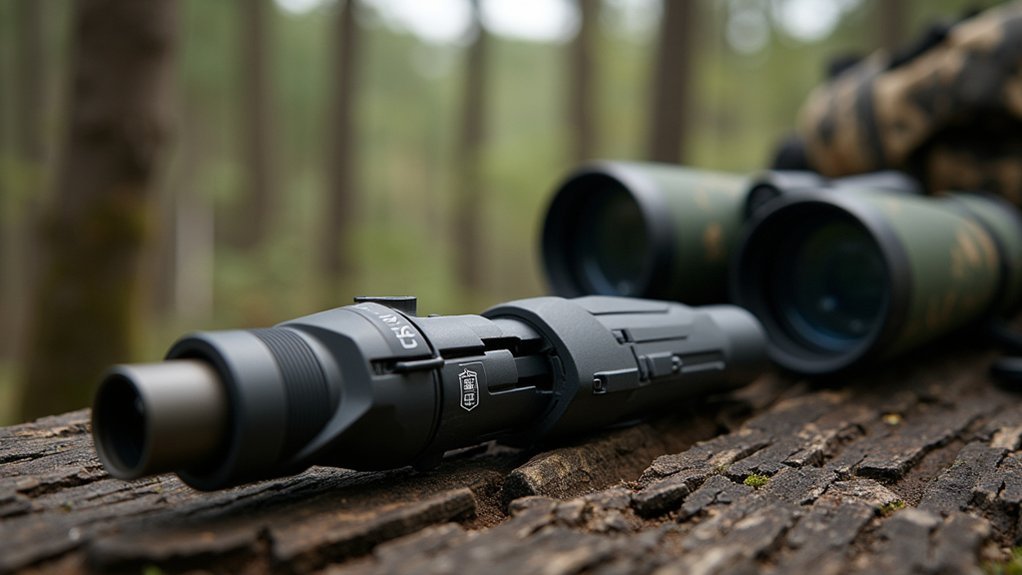
While traditional hunting tools require manual dexterity and two-handed operation, sip-and-puff trigger activation systems have revolutionized accessibility for disabled hunters.
These vacuum-actuated mechanisms allow you to fire your weapon through simple respiratory actions—sipping or puffing—eliminating the need for manual trigger manipulation.
Breathe to shoot—a revolutionary approach giving hunters with disabilities newfound independence through respiratory-controlled trigger systems.
You’ll find these systems attach easily to standard trigger guards on firearms and crossbows, requiring no batteries for operation.
The adjustable gooseneck mounts accommodate various positions and disabilities, enhancing your mobility and independence in the field.
For safety, always use the complementary safety pendant to prevent accidental discharge.
These versatile tools integrate seamlessly with other assistive technologies like power chairs, creating an all-encompassing hunting solution.
Beyond hunting, your sip-and-puff switch can control multiple devices, making it a valuable addition to your adaptive equipment collection.
The standard design features a 19-inch gooseneck that provides optimal positioning flexibility for hunters with limited mobility.
Adjustable Gun Mounting Brackets for Wheelchairs
Three essential benefits make adjustable gun mounting brackets a game-changer for wheelchair-using hunters: stability, versatility, and independence.
These mounts provide a secure platform for your firearm while allowing full range of motion—up, down, and side-to-side—giving you precise aiming control.
You’ll find most brackets compatible with various firearms and wheelchair brands. Installation is straightforward, typically involving placing the mounting plate under your cushion and securing the equipment in the receiver tube.
For hunters with limited arm strength or dexterity, models with 12-volt DC power sources can include height adjustment features and even power trigger mechanisms.
The weight distribution design makes weapons feel nearly weightless, improving your accuracy and reducing fatigue. Designed specifically for individuals with conditions like C5, C6, C7 Quadriplegics, these mounts enable users to operate pistols, crossbows, rifles, and shotguns effectively.
With regular maintenance, these durable mounts will support your hunting adventures for years to come.
One-Handed Crossbow Loading Mechanisms
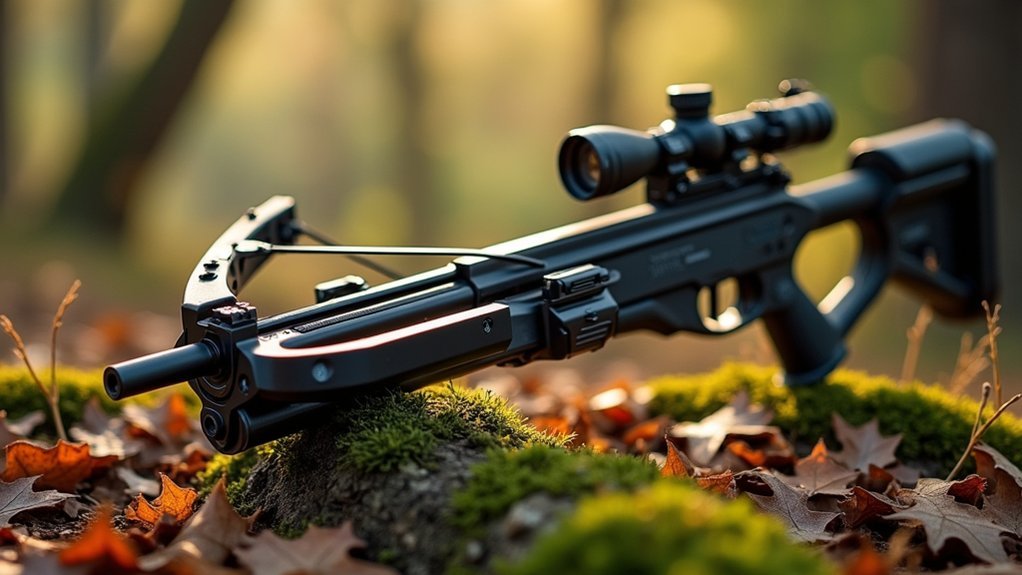
Crossbows offer exceptional hunting capability for disabled sportsmen, but traditional loading methods can present considerable challenges for one-handed users. Fortunately, several adaptive mechanisms have emerged to address this need. For those with MS and similar conditions, utilizing a battery-operated drill adapter can significantly ease the cocking process.
| Mechanism Type | Key Benefit | Best For |
|---|---|---|
| Crankaroo Adapters | Converts to drill attachment | Hunters with arm strength limitations |
| Draw Assist Devices | Reduces drawing effort | Those with partial hand mobility |
| Power Assist Tools | Minimal physical exertion | Hunters with considerable disabilities |
These loading systems considerably reduce physical strain while improving accuracy through consistent drawing. While some options add weight or require investment, they’re revolutionizing accessibility for disabled hunters. You’ll find drawlocks particularly useful as they hold the string at full draw until you’re ready to fire, eliminating the need to maintain tension manually.
Voice-Controlled Hunting Equipment
As technology advances, voice-controlled hunting equipment has emerged as a game-changer for disabled hunters who need hands-free operation.
Bluetooth-enabled game callers respond to voice commands, allowing you to mimic various species without manual adjustments—vital if you’re hunting with limited mobility.
Voice-activated hearing protection combines essential ear safeguarding with the ability to hear environmental sounds and communicate while maintaining a 24dB Noise Reduction Rating. Some models now incorporate Spirit Box technology that enables clearer audio reception during wilderness expeditions.
You’ll appreciate the 60-70 hour battery life during extended hunts.
Smart rifles with voice-command capability can adjust reticle settings and activate rangefinders without pressing buttons.
Meanwhile, voice-enabled GPS systems and trail cameras let you mark locations and track game using only verbal cues.
These innovations guarantee you’re not limited by physical restrictions while maintaining fair chase principles.
Ergonomic Grip Modifications for Standard Hunting Rifles
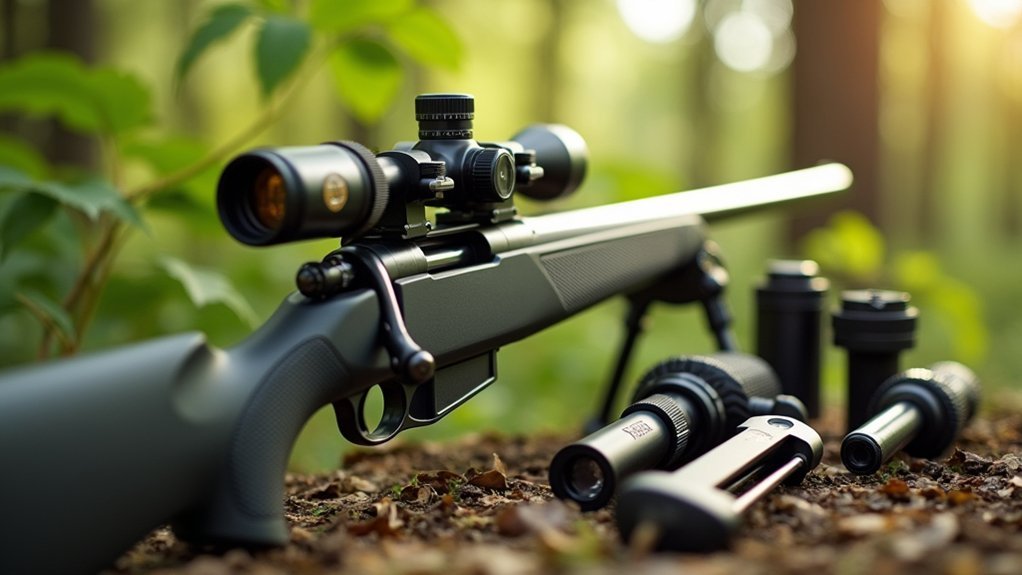
You’ll find modern hunting rifles can be transformed for one-handed use through universal attachment systems that accommodate various shooting styles and disabilities.
Textured surface options, including stippled polymer and rubberized overlays, provide the secure grip you need when operating with limited dexterity. ERGO Grips with aggressive texture and palm-filling contours offer superior control for hunters managing with one hand.
Quick-release grip mechanisms allow you to rapidly adjust your setup in the field without tools, ensuring you’re never caught unprepared when that trophy buck appears.
Universal Attachment Systems
When standard hunting rifles prove challenging for one-handed operation, universal attachment systems transform them into accessible tools without permanent modifications.
These systems feature mounting plates with receiver tubes that install under wheelchair cushions, providing a stable base for your firearm.
You’ll find that 1″ diameter square or circular receivers welded into wheelchair frames offer substantial support with minimal movement.
Locking bolts with ratcheting handles guarantee your gun mount remains secure yet easy to adjust.
Many systems include pivoting vertical masts on ball bearing bases, allowing horizontal aiming adjustments without lifting the rifle.
Extension arms accommodate various seating positions and heights by permitting forward and backward positioning.
These adaptable systems work across multiple wheelchair brands, giving you flexibility while maintaining safety and shooting precision. For optimal results, identify ideal shooting positions that work best with your specific disability while using these attachment systems.
Textured Surface Options
Enhancing standard hunting rifles with textured surfaces can dramatically increase control and safety for one-handed operation. You’ll find several non-permanent and permanent options to improve your grip without sacrificing functionality.
| Method | Difficulty | Permanence |
|---|---|---|
| Adhesive Grips | Easy | Removable |
| Grip Tape | Easy | Semi-permanent |
| Stippling | Advanced | Permanent |
Adhesive-backed texture patches offer a reversible solution ideal for testing different grip positions. If you need more customization, consider epoxy-based texturing which creates durable raised surfaces on composite stocks. For one-handed hunters with specific ergonomic needs, foam and fiberglass sculpting can reshape standard grips entirely. Stippling provides excellent tactile feedback but requires careful application and cannot be undone, making it best for experienced users confident in their grip preferences. Look for specialized TALON Slide Grips that perform well in both wet and dry conditions, essential for unpredictable hunting environments.
Quick-Release Grip Mechanisms
For hunters with limited hand function, quick-release grip mechanisms represent a game-changing advancement in adaptive hunting equipment.
These systems allow you to attach or detach grips instantly with simple push-button or lever operations, eliminating the need for complex tools or fine motor skills.
You’ll benefit from enhanced control and accuracy while maintaining the ability to quickly adapt to changing hunting conditions.
The best mechanisms feature ergonomic designs with extended levers that accommodate various disabilities while remaining secure during use.
Look for options compatible with Picatinny or M-LOK rails that combine lightweight materials with durability.
Practice using your quick-release grip regularly to develop muscle memory.
This tactical advantage lets you maintain stealth, navigate dense terrain, and switch configurations on the fly—crucial abilities when your hunting success depends on one-handed operation.
Many hunters find that vertical QD foregrips provide exceptional stability during aiming, which is particularly valuable for those managing disabilities that affect upper body strength.
Quick-Release Gun Rests and Stabilizers
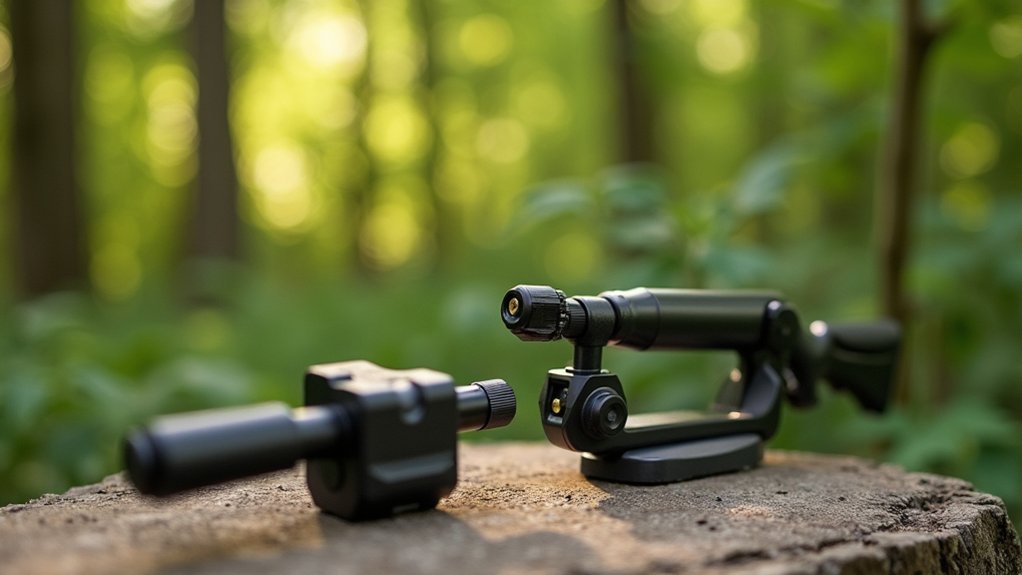
Quick-release gun rests and stabilizers represent essential tools in a disabled hunter’s arsenal, offering both stability and one-handed functionality.
The Kopfjäger Ambush positions your rifle perfectly for precision shots, while the FHF Gear TAC MTN attaches to tripod legs or trekking poles for stable, one-handed deployment.
Primos Trigger Sticks feature a quick-adjust trigger mechanism in mono, bipod, or tripod configurations. Their MagnaSwitch Mounting System guarantees smooth adjustments for hunters with limited mobility.
For enhanced versatility, consider the Swagger Stalker QD42, which converts between bipod and shooting stick with its quick detach technology. The Reaper Grip system provides unshakeable stability while being specifically designed to accommodate shooters with physical limitations.
Materials matter too – look for aluminum construction for lightweight durability and anti-slip surfaces like FHF’s Slip Not material for secure positioning in various terrain conditions.
Mouth-Operated Range Finders and Optics
Mouth-operated rangefinders and optics provide game-changing solutions for hunters with limited or no upper limb mobility.
These devices feature ergonomic mouthpieces with intuitive bite-activated controls, allowing you to measure distances and adjust magnification without using your hands.
Today’s models incorporate high-precision sensors in compact, weatherproof designs that integrate seamlessly with your existing hunting gear.
You’ll appreciate their extended battery life for all-day hunts and the lightweight construction that prevents jaw fatigue. Many models offer angle compensation technology similar to the Gogogo Sport Vpro rangefinder, helping you make accurate shots from elevated positions.
Look for options with user-friendly tutorials and universal mounting systems compatible with various firearms.
Many jurisdictions offer special provisions for disabled hunters using these tools, so check local regulations before your trip.
The hunting community has embraced these innovations, with positive user reviews highlighting how they’ve restored independence and accuracy for one-handed hunters in the field.
Specialized Gun Slings for Limited Mobility
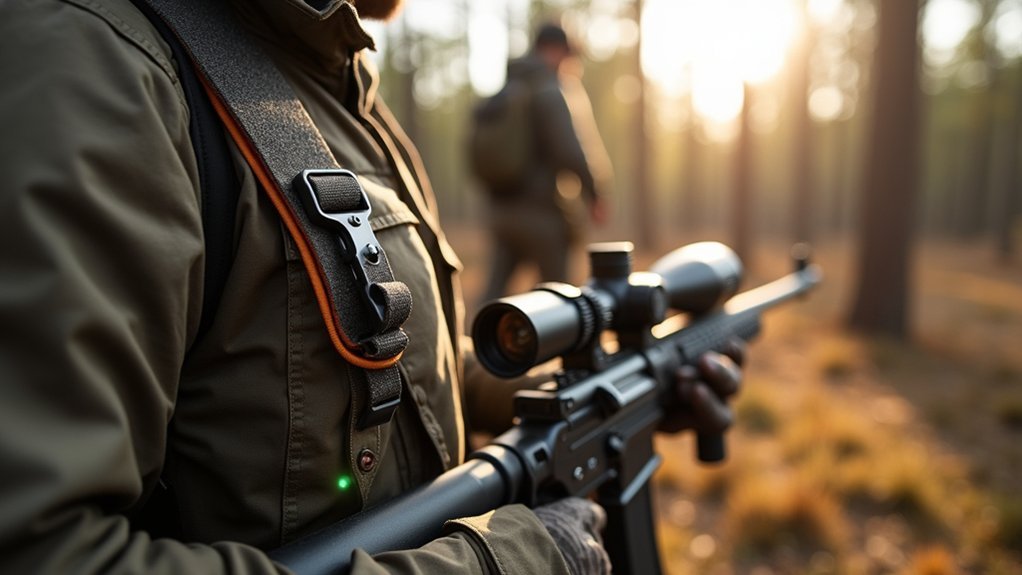
Specialized gun slings offer you game-changing support through easy-release stabilizing designs that maintain firearm security while allowing quick one-handed access.
Quick-adjust mobility harnesses adapt to your specific needs, whether you’re hunting from a wheelchair or managing with limited arm strength.
These customizable systems integrate with modern picatinny attachments, providing stability without sacrificing your ability to respond swiftly to hunting opportunities. For enhanced precision while using limited mobility equipment, the hands-free trigger activation option allows you to fire any gun without requiring manual dexterity.
Easy-Release Stabilizing Slings
For hunters with limited mobility or the use of only one hand, properly designed stabilizing slings represent a critical advancement in adaptive hunting equipment. These slings feature quick-release mechanisms that allow you to deploy your rifle rapidly without removing your pack or using your other hand. The availability of both QR and QD options makes these slings adaptable to various weapon mounting systems while maintaining ease of use for disabled hunters.
| Feature | Benefit | Application |
|---|---|---|
| Tactile Pull Cords | Locate release points by touch | Enables operation without visual confirmation |
| Non-slip Panels | Prevents rifle shifting | Maintains stability during movement |
| Quick-Adjust Webbing | Creates supportive shooting loops | Improves aiming stability and recoil control |
The sling’s minimalist design prevents snagging during deployment while distributing weight evenly across your body. You’ll appreciate how these systems integrate with other adaptive gear, offering one-handed adjustment and customizable tension to suit your specific mobility needs.
Quick-Adjust Mobility Harnesses
Quick-adjust mobility harnesses build upon the foundation of stabilizing slings while offering advanced support for hunters with limited mobility.
Inspired by lineman’s belts, these harnesses feature one-handed adjustment mechanisms that enable quiet, rapid positioning with minimal effort.
You’ll appreciate the hybrid design that prevents hip pinching during extended wear, while neoprene silence covers guarantee stealth during adjustments. Similar to PetSafe’s CareLift Support Harness, these hunting tools provide even weight distribution to prevent back strain during use.
The flush adjustment points are strategically positioned for easy access when seated.
Safety isn’t compromised for convenience—these harnesses incorporate alpine buckles rated for 1800 lbs and rings rated up to 7200 lbs.
The patented tether attachments provide secure firearm retention while allowing quick tension adjustments with a single hand, improving your shooting readiness and stability regardless of mobility challenges.
Adaptive Bow Release Aids for One-Handed Operation
While traditional archery requires two functioning hands, adaptive bow release aids have revolutionized hunting accessibility for those with limited dexterity or missing limbs.
These specialized tools let you control your bow with precision despite physical limitations. Custom designs, like those that position straps high on the collar, can ensure proper back muscle engagement during draws.
Wrist-strap releases offer stability while mechanical trigger systems require minimal finger movement. For hunters with severe mobility restrictions, mouth-activated options provide complete hands-free operation.
- Mechanical and caliper releases – Attach to your wrist for stability and require just a light trigger pull
- Hinge-style and tension-activated systems – Allow for smooth drawing and release with minimal hand function
- Mouth-triggered and strap-mounted aids – Enable completely hands-free operation by mounting to alternative body parts
Most adaptive releases work with both compound and recurve bows and feature adjustable components for personalized comfort.
Remote-Controlled Game Calls and Attractants
You’ll find hands-free calling devices invaluable for attracting game while keeping your limited mobility in mind. The Cass Creek Nomad Game Call features five authentic sounds that can be activated remotely while maintaining your concealed position.
Voice-activated scent dispensers let you deploy attractants at strategic moments without manual intervention.
Mobile app controllers offer unprecedented flexibility, allowing you to manage multiple calls and attractants from your smartphone with just one hand.
Hands-Free Calling Devices
For disabled hunters with limited hand mobility, remote-controlled game calls offer a game-changing solution. The Cass Creek Nomad system provides a lightweight, wireless experience with multiple receivers that create realistic moving sound effects.
You’ll appreciate the authentic field-tested sounds recorded from real animals.
Systems like these enhance your hunting experience through:
- Directional Control – Position receivers strategically to attract game from different angles
- Simple Operation – Easy-to-use remotes eliminate the need for manual calling techniques
- Customizable Setup – Adjust volume based on environmental conditions and use up to three receivers simultaneously
These hands-free devices feature extended battery life and compact designs ideal for hunters with mobility challenges.
Most importantly, you can control these calls from a distance, maintaining your concealment while effectively attracting your target game. Organizations may provide financial assistance for acquiring these adaptive hunting technologies, reducing the cost burden for disabled hunters.
Voice-Activated Scent Dispensers
Hunters with limited hand dexterity can now control their hunting environment through advanced voice-activated scent dispensers. The Wyndscent 2.0 leads this category with its remote control capability, allowing you to adjust scent dispersal from up to 300 yards away without physical contact.
These devices integrate seamlessly with assistive technologies, enabling one-handed operation. Wyndscent’s long-lasting cartridges provide up to 40 hours of use, while Heated Hunts heats scent to 105°F, mimicking natural big game temperatures. The customizable system permits you to set scent release at 1 or 3-minute intervals to match your hunting strategy requirements.
You’ll appreciate how these dispensers optimize wind patterns to distribute attractants effectively. For maximum versatility, look for models featuring adjustable intervals and scent intensity settings.
When paired with other adaptive hunting gear, these voice-activated systems transform the hunting experience, placing you in control regardless of physical limitations.
Mobile App Controllers
Modern mobile app controllers revolutionize accessibility for disabled hunters by transforming smartphones into command centers for game calls and attractants.
Systems like the Cass Creek Nomad allow you to control multiple receivers simultaneously, creating realistic moving sound effects without physical relocation.
For one-handed operation, consider these game-changing options:
- Wireless remote systems – Devices like Primos Double Take offer 200-yard range with 24-bit sound quality, letting you stay stationary while effectively calling game. The POINT BLACK PB-TDT Diaphragm Turkey Call features 300 ft range with remote control capabilities, making it ideal for hunters with mobility limitations.
- Multi-directional speakers – Position multiple receivers to create more natural sound patterns, increasing your chances of attracting prey.
- SD card compatibility – Update and customize your call library without complicated equipment, accessing new sounds directly through compatible mobile interfaces.
These technologies eliminate the need for traditional manual calls, making hunting more accessible regardless of physical limitations.
Frequently Asked Questions
How Do I Finance Adaptive Hunting Equipment on a Limited Budget?
You can finance adaptive hunting equipment through VA funding if you’re a veteran, state AT programs, non-profit grants, installment plans with no interest, or low-interest loans from state-specific programs like Alabama’s Ability Loan Program.
Can Adaptive Equipment Be Used During Standard Hunting License Qualification Tests?
Yes, you can often use adaptive equipment during standard hunting tests, but check your local regulations first. Many jurisdictions allow accommodations, though specific rules vary by state and equipment type.
What Weather Limitations Affect Electronic Adaptive Hunting Equipment?
Your electronic adaptive hunting equipment can malfunction in extreme temperatures, moisture, and wind. Cold drains batteries faster, rain can damage components, and wind affects accuracy. Always use weatherproof options and carry backup systems.
Are There Rental Options Available for Trying Different Adaptive Tools?
Yes, you can rent adaptive hunting tools through outdoor education centers’ gear libraries, specialized hunting organizations like Buckmasters chapters, and programs like Michigan Operation Freedom Outdoors that loan equipment during organized hunts.
How Much Training Time Is Typically Needed to Master Adaptive Equipment?
You’ll need varying training time to master adaptive equipment—typically several weeks to months. Your progression depends on your specific abilities, practice frequency, and the complexity of the tools you’re using.
In Summary
You’ve seen how adaptive hunting equipment continues to evolve, making the outdoors accessible to everyone. Whether you’re using sip-and-puff systems or voice-controlled gear, don’t let physical limitations stop you from pursuing your passion. These tools aren’t just practical—they’re game-changers. With the right equipment, you’ll find that one-handed hunting isn’t about limitations; it’s about discovering new ways to enjoy the sport you love.

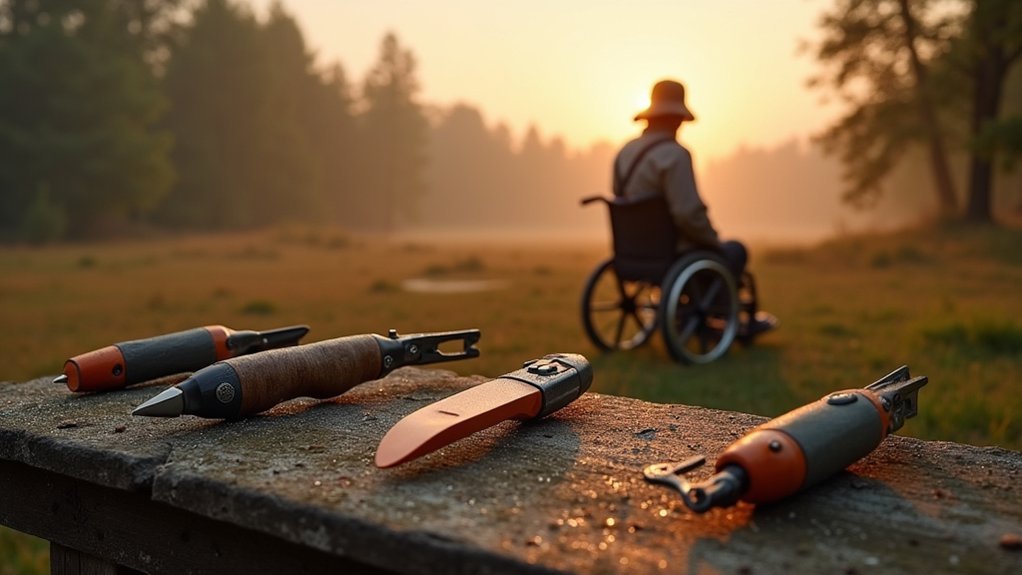



Leave a Reply